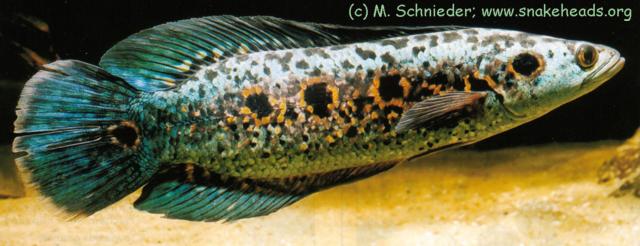
The family Channidae was recently enriched with 3 newly described species, Channa panaw (1998), Channa aurantimaculata (2000) and Channa nox (2002), that are suitable for the aquarium. Among the ca. 40 species of snakehead there are some that are distinguished from other Channa by their behavioral biology. Very different in their behavior but also suitable for the aquaristic are Channa pleurophthalma and Channa sp. "Himalaya" , two very colorful species I would like to introduce in this report. There are many open questions, especially about their clear identification.
The reason for this is very specific. It is not as easy to identify the different species through coloration and markings as it is with other aquarium fish. Nearly all Snakeheads have different colors and markings as juveniles compared to an adult specimen. Also some snakeheads can change their color and markings within seconds depending on the situation (disturbances for example). Since science has neglected the family of snakehead fish so far, it is no wonder that there are so many species names in Literature that are obsolete or strictly wrong.
ToC .
Even Channa pleuropthalma , one of the most beautiful freshwater predators, was the victim of several misdescriptions. In the scientific work New reports of the knowledge of the ichtyo fauna of Borneo until now and the description of new species of freshwater fish (English translation of the Dutch title) from 1851 Bleeker described a fish of the family Channidae, that is named keradung by the Indonesian people. Bleeker scientifically named it Ophicephalus pleurophthalmus (now Channa pleurophthalma ). Only a year later Bleeker described with Ophicephalus urophthalmus a new species of snakehead, which was clearly different from Channa pleurophthalma both in body and color. Later discoveries showed that Bleeker described a juvenile Channa pleurophthalma . Another questionable Species description was Ophicephalus spiritalis in 1904 by Fowler. However he recognized the similarities to Channa lucia and Channa pleurophthalma .
 | C. pleurophthalma in adult state. Only when it is adult C. pleurophthalma gets this breathtaking blue-metallic color. |
ToC .
The English name, Eyespot snakehead, is very specific, as the 5 ocelli (eyespots) are the most dominant feature of Channa pleurophthalma . The long body is laterally heavily compressed like with no other Channa species. It is especially visible on the high build adults. The fish reaches 40 cm (16" in length, the «spiritalis»variant being a little smaller, and is one of the smaller giants. However these snakeheads like to swim more than other Channa and should have a tank of a minimum of 500-liter volume.
The natural distribution of Channa pleurophthalma is very limited. There are reportsfrom Sumatra (southeast) and Borneo (west). There the climate is tropical throughout the year with average monthly temperature of 26 to 28 °C (80-84 F°). There are no reports of natural observations, which only leaves the observation of the fish in an aquarium.
As all snakeheads this species possesses an accessory breathing organ the so-called suprabranchial organ. Like labyrinth fish snakeheads regularly surface to breathe air. With the help of the suprabranchial organ snakeheads can survive in extremely oxygen-depleted water. However this Channa pleurophthalma prefers flowing waters where it hunts and lives in groups. Channa micropeltes according to VIERKE forms hunting groups in nature. So it could be possible that Channa pleuropthalma hunts in the same manner by herding their prey in front of them. The prominent eyespots on the body flanks could play an important role. When the prey is close enough to the mouth the snakehead will suddenly strike and release all the air in the suprabranchial organ. This will enable the fish to literally suck its prey in. not only fish are taken as prey but also crabs and crustaceans, shrimps, insects and tadpoles.
Even so it is harder to get Channa pleurophthalma used to alternative foods then other snakeheads, the food pallet can be enriched with garden worms, mealworms large mosquito larvae and maggots. Dry foods are unpopular and will get usually ignored. Snakeheads are no food specialists, which means they do not depend on a particular source of food. In their dissected stomachs of Channa melasoma for example, who live in similar biotopes in Sumatra and Borneo, scientists have found fish like nine eyes and barbs, crabs and other crustaceans, and even a small lizard of the genus Tropidophorus . 1 To eliminate any chance of malnutrition the diet for snakeheads should be as diverse as possible.
No problem as with all snakeheads is the water chemistry. Even so ROBERTS & WOERJOATMODJO caught the eyespot snakehead in biotopes as extreme as the coffee brown jungle creek Sungay Kebianon on Kalimantan, Borneo where the pH of the water is as low as 5.5, 2 , this is not necessary for the Aquarium. A pH of up to 7.5 is absolutely acceptable and also against other water perimeters the fish are surprisingly flexible. However it is a good idea to enrich he water with traces of elements to ensure the health of the fish
Channa pleurophthalma are more peaceful then most snakeheads and fish not seen, as prey will be left alone. Nevertheless the fish should not be kept with to large species like some cichlids as they can be very shy and timid. Eyespot snakeheads are tolerant of their own kind and can be kept in groups. Occasionally there will be torn fins, especially after a larger water change, but they do heal remarkably fast.
The preferably long Aquarium can be furnished with bogwood and tough solitary plants. Dense foliage and delicate stem plants would be destroyed by the fast moving Channa . A fast current and a temperature of 26 C° seem to be beneficial to the fish. Since these fish have a very high metabolic rate a sufficient Filtration system is essential to cope with the waste products.
With good water quality and a healthy diet, females will get larger in the belly region indicating their readiness to spawn. Other than that the sexes are very hard to determine. If spotlight is used males will show a strong blue and the females a blue green coloration. So little is known about their breeding behavior, that we can only speculate about it. During the breeding season the dominant males and females will separate from the group to spawn. it is possible that the same behavior is displayed as with most snakeheads, several «practice» runs where the male embraces the belly region of the female which get more intense leading up to the actual spawning. The spawning pair will choose a shallow, slow moving spot, as Channa pleurophthalma is certainly no mouth brooder, where the male will guard the raft of floating eggs.
ToC .
As Channa pleurophthalma are very rarely on sale, most hobbyist wanting to keep these stunningly colorful fish will be disappointed. However there are alternatives. New sites for catching snakehead in the north east of India are producing new species like for example Channa aurantimaculata , a species that is of stunning color and markings but yet very different from Channa pleurophtalma .
 | An adult C. aurantimaculata. This species can show colors which make you feel like in a rainbow. |
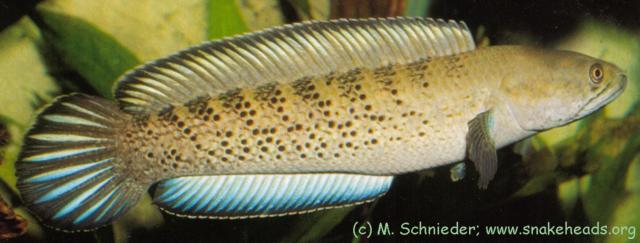 | This is very probably C. stewartii. |
ToC .
Since Channa sp. "Himalaya" is a new import and no literature is available I had to contact the importer to find out more about the origin of the fish. As the name suggests it is an undescribed species of snakehead from the Himalaya region of India, from Alipur Duar (Western Bengal) to be precise.
In these subtropical climate the average temperature is 16 to 18 C° in the winter and 26 to 28 C° in the summer. In other words: Channa sp. "Himalaya" is very much suited for an unheated aquarium kept at room temperature. From observations in the aquarium we can reach the conclusion that these fish hunt primarily on the shorelines of slow moving waters. In contrast to Channa pleurophthalma , Channa sp. "Himalaya" do not belong to the group of typical piscivores even so these snakeheads take fish as prey. The largest part of their diet are shrimps, crabs and insects but garden worm, maggots and most frozen food are taken easily as well as some sticks and pellets.
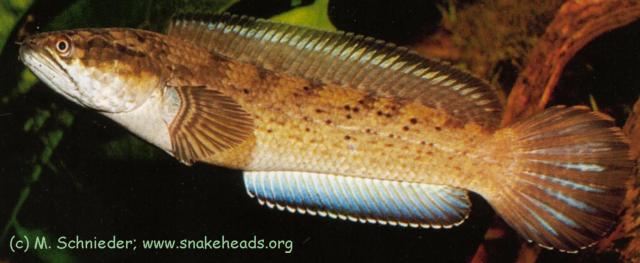 | C. sp. Himalaya female. It has less black spots as the male. It is like C. asiatica, from which is said that the females do have less scales glittering than the males. |
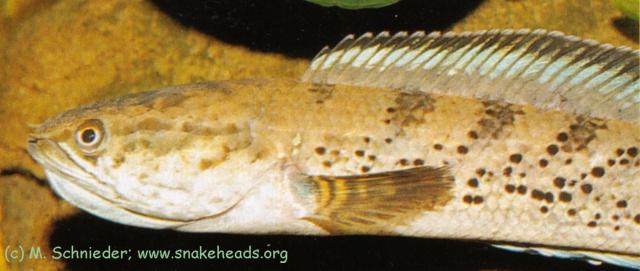 | C. sp. Himalaya male. Typical for Channa is that the male is the mouthbrooding part. |
The size of the tank is an important factor if several of the fish are to be kept together. The tank should be fairly large, because even so Channa sp. "Himalaya" doesn't exceed 20 cm (8") it is very aggressive towards its own kind. I housed 4 of these fish ,12- 16 cm (5-6.5"), in a 110x50x50 cm (44x20x20") tank until a pair formed. After my experiences this is important since most successful broods originate from pairs that have formed in a group. During the pairing process the water perimeters where: Temperature 22 C° days and 20 C° nights, the pH around neutral at 7, carbonate hardness 4-5 dH, total hardness 11-14 dH and conductivity 370 nano siemens
I was very surprised when the fish suddenly spawned. I did realize that 2 of the Himalaya didn't attack each other anymore, but to say that they where harmonious would be said too much. Also I didn't notice any of the pretend spawning which is typical for most snakeheads. I did notice a further difference in the tank. Around one of the roots a shallow pit had been dug where the male spent a lot of time. The male was very inactive and was hiding a lot. Since the male had a swollen throat sack and was refusing food only one conclusion was obvious, Channa sp. "Himalaya" is a mouth brooder.
In comparison with other mouth breeding Channa (see AF 162, "Eggfeeding snakeheads") , there are some differences. The behavior of the female, not showing any care for the brood, was very strange in deed. It did not visit the male or attack any of the tank mates. However this behavior changed 6 days after spawning. Now the female stayed with the male more often and attacked all the other fish so viciously that I had to remove them. 10 days after spawning the brood left the mouth of the male for a first short period of time. A day later the young swam in a large dug out pit with the male watching over them. Now it also began slowly to feed again.
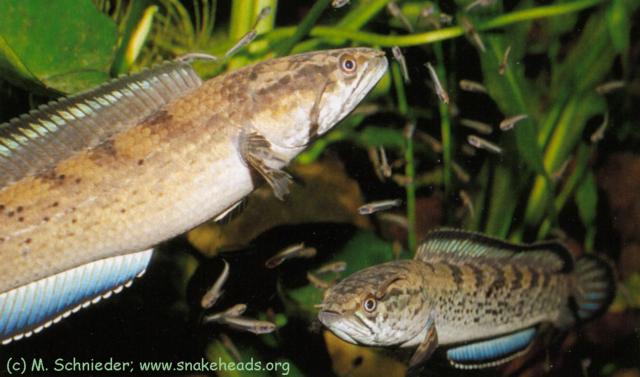 | C. sp. Himalaya couple with brood. Left side the female, right side the male. |
The size of the 100 to 120 young was remarkable in comparison with Channa gachua fry of the same age. 13 days after spawning the "bunched up" young surfaced for the first time.
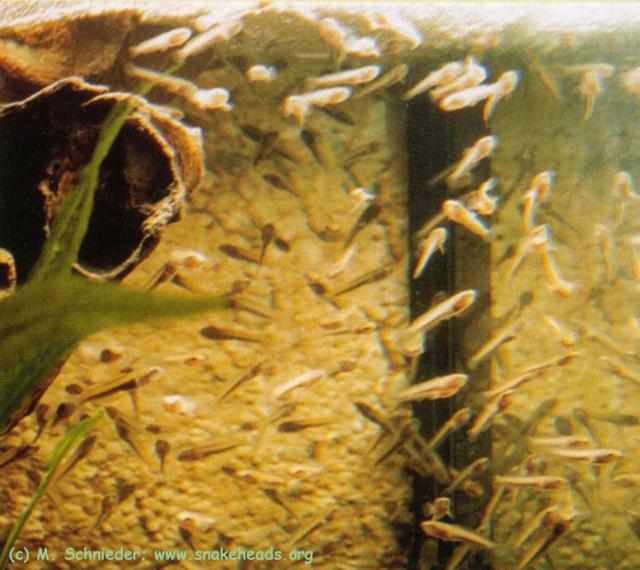 | C. sp. Himalaya brood below the bubble nest. This is one of the rare pictures showing mouthbrooding Channa below a bubble nest. Until now, this is the only Assamese mouthbrooding Channa of which we know it builds a bubble nest! |
However I was still worried about the young snakeheads as they refused to take food. Cyclops , Bosmides and small mosquito larva were only taken occasionally. What to do? I mashed a few mealworms and successfully fed them to the young. After time they also took the usual frozen foods and the mashed mealworm at all times. After 3 weeks I could clearly see the young surface to breathe air. During this period there was frequent bodily contact between the young and their parents. . After only 4 weeks the little snakeheads had an amazing body length of 2 - 3 cm (3/4 - 1.1/4 "). I started to get worried about the young, thinking the parents may see them as food, and removed the adults from the tank.
Finally some general tips. Unlike may other species of snakehead Channa pleurophthalma be able to be very easily scared. The fish always beg for food if their keeper enters the room but should something unusual happen, they will dive for cover as quickly as possible below a root or behind a plant. Care is advised when feeding and handling Channa pleurophthalma as they have razor sharp teeth. Fish ones grabbed by the large mouth have no chance of survival even if they should manage to escape. The sharp teeth and powerful jaws inflict to serious wounds. Therefore care is advised when selecting tank mates for the fish.
Lastly one little story. To take care of the algae growth in my pleurophthalma tank I selected an Ancistrus catfish, thinking it would not be seen as food since it as armored with spines. At some point I could hear the large male jump against the cover glass, which I screwed down, several times. What had happened? The male had decided that Ancistrus was on the food pallet and swallowed the catfish. To protect itself the Ancistrus extended all the hard spines on his body and got stuck in the throat of the Channa with his spines going through the gills. I had to get my priorities right and caught the fish is a net, wrapped it in a wet towel and got the smallest scissors available opened the gill covers and started to cut the spines of the catfish. In the end the large Channa managed to swallow the fish with some difficulty and survived the procedure. It certainly taught me a lesson and anyone that has ever kept a large snakehead has surely similar experiences.
Even so the snakeheads brains are comparably small, 0.285 gram in a 210 gram Channa orientalis , they are still capable to learn. This data should be similar for most snakeheads or maybe even lower. But it is the snakehead that survived thousands of years. The earliest fossils date back to the Pliocene and are therefore ca.2 million years old.
ToC .
1 The author has taken it from the following publication: Inger, R.F.; Chin, P.K.: The freshwater fishes of North Borneo . 1962. Fieldiana: Zoology. Vol. 45. Chicago Natural History Museum. p. 154ff. [snakeheads.org] Back
2 The author talks of Roberts, Tyson R.: Freshwater fishes of Western Borneo . 1989. Memoirs of the California Academy of Sciences Number 14. ISBN 0-940228-21-1. pp. 15, 170. [snakeheads.org] Back
3 «I also found this fish for sale as Channa barca in England and America» [Ulrich for snakeheads.org] Back
This text was originally published in German and was published in: Aquaristik Fachmagazin Nr. 171 Juni/Juli 2003. pp 38-42. The author has granted snakeheads.org the right to publish it on the org's site. The copyright of text and photos is still with the author/photographer in full amount. Thank you Uli for translation. You did a very good job and you helped us much!!
| © 2001 - 2003 snakeheads.org | HOME of this page |